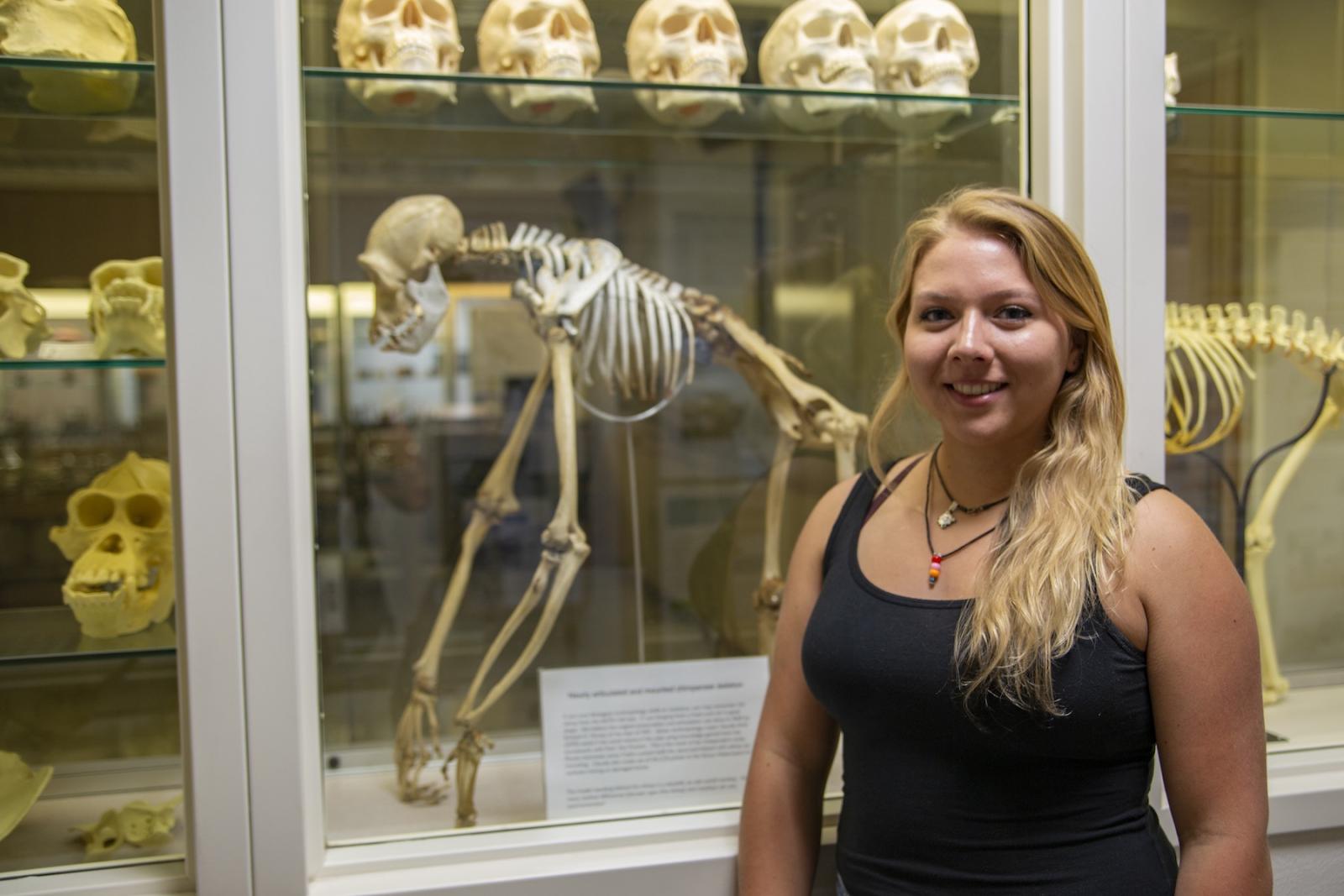Claudia Rohr ’19 remembers when Dan Proctor, a Lawrence University visiting assistant professor of anthropology, first wheeled an old chimpanzee skeleton into the forensic anthropology classroom.
A sophomore at the time, Rohr was struck by the skeleton’s appearance — the skull and torso hung limp from a hook and the limbs rested on a nearby table. There were missing pieces and backwards parts that made its purpose as a teaching tool difficult to fulfill.
Proctor said he was looking to have a student rearticulate and refurbish the skeleton. Make it useful again. Rohr was immediately interested.
With some help from the Mudd Library’s Makerspace and the physics department, Rohr spent much of the spring term rearticulating the skeleton as an independent study project.
“I thought it would be really cool if it could be put together well because Lawrence doesn’t have a lot of primate-related things,” she said.
The skeleton’s origins are unknown. For as long as anyone in the Anthropology Department can remember, it has hung on its stand on the third floor of Briggs Hall. It is believed that Lawrence student Richard H. Dorsey ’51 first articulated the skeleton in 1949, threading wire through small drilled holes in the bones to fasten them. But time and outdated articulation techniques eventually pushed the skeleton into disrepair.
To start her ambitious project, Rohr spent some late nights disassembling the skeleton, pulling wire apart from bone. She then took inventory of what bones she had and, with an osteology textbook at her side, deciphered which of the numerous tiny bones belonged to hands and which to feet. Eventually she was able to glue everything together and reattach the arms and legs to the torso.
But what to do about the missing bones? With training from Angela Vanden Elzen in the Makerspace, Rohr learned how to 3D print the missing bones using the existing parallel ones for reference. Most of these were finger bones. She quickly got the hang of it and printed with a resin so well matched to the skeleton’s original color that it’s difficult to tell the authentic bones from the fabricated ones.
With all the bones accounted for, the skeleton needed a new display configuration that would do justice to Rohr’s work and the chimpanzee itself. For this, Rohr reached out to LeRoy Frahm, the longtime electronics technician for the physics department. Frahm constructed a custom stand for the skeleton that would support its new knuckle-walking position.
The joint assist from anthropology, physics and the Makerspace carried Rohr’s project beyond an ordinary independent study.
“I thought it was really cool being able to work with everyone,” Rohr said of the collaboration. “LeRoy and Angela were really into it. It all worked together really well.”
Rohr graduated in the spring. From an academic perspective, the hands-on project turned out to be an excellent supplement to her double major in biological anthropology and biology.
“It was a way to expand my work with primates,” she said. “It was cool being able to see how the skeleton works as a whole and how different bones are articulated, rather than just looking at it for a day or two in class and then being tested on it.”
Rohr recently returned from her second research trip to Peru, where she studied the behaviors and disease ecology of New World monkeys.
Associate Professor of Anthropology Mark Jenike said the skeleton will be more useful than ever as a teaching tool in anthropology lab classes.
“People can look at it more easily now than they would’ve been able to when it was hanging from that hook,” he said. “It’s really for seeing what the whole skeleton together looks like, the way in which the chimpanzee would have been when it was alive.”
The value of Rohr’s project is far-reaching.
“It’s a form of respect to the skeleton,” Jenike said. “The chimpanzees are our closest living relative species. They have culture, they make tools, they seem to show emotions. … The chimp itself deserves respect. I think this is a more respectful way of displaying it than hanging from a hook with parts falling off.”
Rohr’s work is displayed in a hallway on the third floor of Briggs, visible to all who pass, including prospective students on campus tours. It stands as a testament to Lawrence’s commitment to academic excellence and the value of interdisciplinary teamwork.



